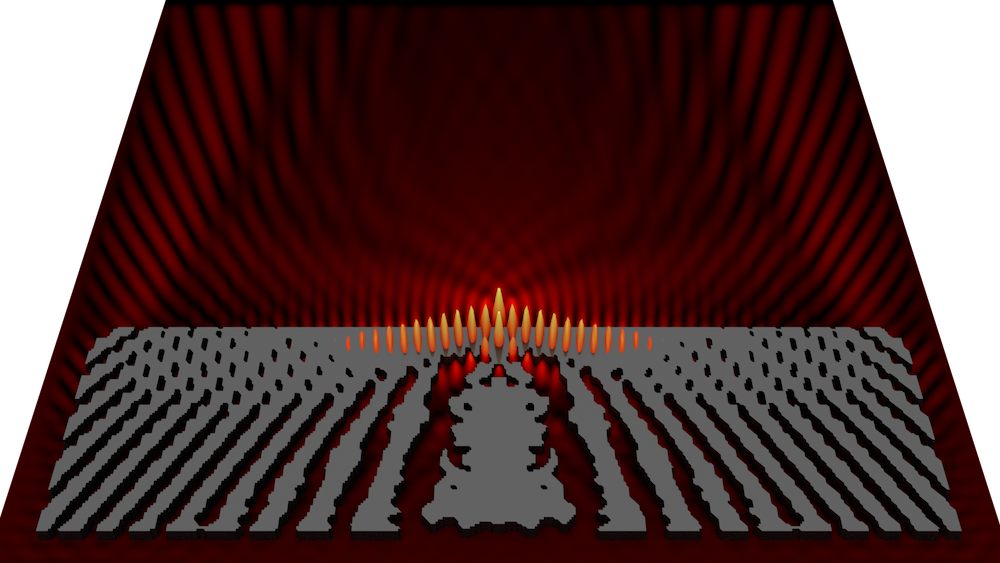Introduction
Photonic materials made of carefully designed structures can manipulate light in extraordinary ways, enabling applications in imaging, sensing, information processing, and beyond. Designing such materials involves solving inverse problems: instead of determining how a given structure interacts with light, we start with a desired optical response and work backward to find the optimal material configuration. This requires advanced numerical approaches, both model- and data-driven, and a high-performance computing infrastructure to efficiently explore vast design spaces and achieve precise control over light propagation. Our NHR project allows us to tackle these challenges.
| Principal investigator: | Prof. Dr. Carsten Rockstuhl |
| Project manager: | Dr. Marjan Krstić |
| Researcher: | Dr. Markus Nyman |
| Date published: | February 2025 |
| HPC platform used: | HoreKa |
| Institute: | Institute of Theoretical Solid State Physics |
| Affiliation: | Karlsruhe Institute of Technology (KIT) |
| Research field: | Photonics |
| Project ID: | Bits2Blobs |
Project description
In our project, we design photonic materials and devices with tailored properties. Our work pioneers inverse design strategies to create photonic systems with precisely defined functionalities. By leveraging high-performance computing resources, we address inverse problems in photonics through model- and data-driven approaches. We enhance these methods with quantum chemistry calculations to achieve a comprehensive understanding of the underlying photonic materials, allowing us to predict intrinsic material properties at the molecular level.
Our methodology integrates adjoint-based inverse design, neural network surrogate solvers, and multiscale optical simulations. The adjoint-based approach facilitates rapid optimization of photonic structures, requiring only two full-wave electromagnetic simulations to calculate gradients. Neural network-based surrogate solvers, such as Fourier Neural Operators, speed-up the inverse design by effectively approximating Maxwell’s equations. Finally, multiscale optical simulations link quantum chemical calculations at the TD-DFT level with macroscopic Maxwell solvers, allowing us to incorporate molecular-scale optical properties into the design of larger photonic systems. The current project explores explicitly three subjects.
First, we focus on the inverse design of flat optical elements using Fourier optics. Fourier optics is powerful to simulate and optimize devices like metasurfaces and diffractive optical components. By utilizing differentiable programming, we design metasurfaces for applications such as extended depth-of-field in optical microscopy, spectral splitting for solar cells, and devices for the beam shaping of high-power laser [1].
Second, we apply topology optimization to design three-dimensional photonic devices. These devices shall be fabricated using 3D nanoprinting. Our approach ensures the structural integrity of designed devices while enabling intricate optical functionalities. To further accelerate the design process, we explore neural network-based surrogate solvers that efficiently approximate Maxwell’s equations [2].
Third, we advance multiscale optical simulations by integrating quantum chemical calculations at the TD-DFT level to analyze the optical properties of molecular materials. By embedding these molecular-scale insights into macroscopic Maxwell solvers, we achieve a comprehensive understanding of 3D photonic materials across multiple length scales. Building on previous efforts, this work now investigates chiral optical responses and nonlinear effects such as second-harmonic generation [3].
Our project pushes the boundaries of computational photonics by refining inverse design methodologies, advancing multiscale modeling, and embedding machine learning into optical simulations. These innovations are expected to drive groundbreaking applications in optoelectronics, optical sensing, and photonic computing, reinforcing inverse photonics as a transformative tool for shaping the next generation of optical systems.
References
[1] T. J. Sturges, M. Nyman, S. Kalt, K. Pälsi, P. Hilden, M. Wegener, C. Rockstuhl, and A. Shevchenko, „Inverse-designed 3D laser nanoprinted phase masks to extend the depth of field of imaging systems“ ACS Photonics Vol. 11 3765, (2024)
[2] O. Kuster, Y. Augenstein, R. N. Hernández, C. Rockstuhl, and T. Jebb Sturges, „Inverse Design of 3D Nanophotonic Devices with Structural Integrity Using Auxiliary Thermal Solvers“ arXiv:2501.05900 (2025)
[3] B. Zerulla, A. Luna Díaz, C. Holzer, C. Rockstuhl, I. Fernandez-Corbaton, and M. Krstić, „Multi-Scale Modelling of Surface Second Harmonic Generation in Centrosymmetric Molecular Crystalline Materials: How Thick is the Surface?“ Advanced Optical Materials Vol. 12 2400150, (2024)

